CeNTech – Nanotechnological Research and Application
Abstract: The Centre for Nanotechnology (CeNTech), Münster, Germany, represents one of the first dedicated nanotechnology centres in Germany providing space and infrastructure for application, research and development in the area of nanotechnology. It offers an optimised environment for entrepreneurs to fur- ther develop their research ideas into marketable products as well as excellent conditions for application ori- ented research and further education. Three years after the opening of the CeNTech building most of the ex- pectations are fulfilled. The article describes the general aspects of the CeNTech concept and reviews its de- velopment in the first years.
Introduction
Nanotechnology is a rapidly growing interdisci- plinary field. To foster the cooperation between science and industry nanotechnology centres were founded. The centre for nanotechnology (CeN- Tech) in Münster was created as one of Germany’s first centres of its kind being collaboratively sup- ported by the state of North Rhine-Westphalia, the University and the City of Münster. CeNTech is located in a state exhibiting the largest number of inhabitants in Germany and is integrated into the densest network of universities all over Europe. Three years after CeNTech opening synergetic ef- fects become clearly visible.
Concept and Ideas
The basic and overall concept of CeNTech provides the environment to perform basic re- search with strong application perspectives and to direct selected ideas and results of nanoscience into technical applications. Short in-house ways and a creative mixture between different scientific disciplines provide a fruitful background. Central to this basic concept is the promotion of start-up companies that originate from university research as well as the settlement of existing companies with nanotechnology and nanobiotechnology background. Evidently, patent support and con- tacts providing financial support are essential for the expansion of companies in the field. Another aim of CeNTech is the promotion of education ranging from level of schools to advanced training of external scientists in the field of nanotechnol- ogy, resulting in the concept of Integrated Nanotech- nology (Figure 1).
CeNTech consists of a unique structure that has a complementing character in terms of com- bining research work and infrastructural, market- ing, project proposal, exploitation, PR, patent, educational, and organizational activities. It con- sists of two different parts – a corporation (GmbH) and a research and development (R&D) department. Researchers and companies are sup- ported by legal entity – CeNTech GmbH, i.e. a corporation providing an optimised infrastructure, support for preparation of patents, initiation and evaluation of projects, initiation and realization of know-how transfer towards industry, initiation and support of start-up founding processes, public re- lations, workshops, marketing and further educa- tion. By founding such an economically oriented structure research is transported much closer to the economic value creation chain. The gap be- tween basic and applied research and industrial ex- ploitation could be reduced significantly by im- plementing this system that actively seeks techno- logical ideas, potential products, special know- how, and project ideas for third party funding. Re- searchers are interviewed in regular personal meet- ings where in a common approach the potential values shall be identified if not already clear. The researchers are well supported by the CeNTech GmbH and can therefore better focus on their main strengths and passion: research and devel- opment.
The R&D part of CeNTech is dealing with nanotechnology research preferentially in the areas of nanoanalytics and nanobiotechnology. Within these foci the projects in CeNTech include the op- timization of scanning probe microscopy such as STM, AFM [1, 2] and advanced x-ray- and light microscopy techniques [3], the study of novel ma- terials and nano-scaled template structures [4], the analysis of biophysical effects especially in intra- and intercellular processes, and the development of new approaches for the utilization of biological and biochemical processes in nanotechnology.
In these areas CeNTech researchers co-operate with groups in Germany, Europe and maintain close relations with research centres in the USA, Israel, China, and Japan, working together on nanoscience projects and exchanging visiting re- searchers. In particular CeNTech is engaged in the first German-Chinese Centre for Nanoscience (GCCN) which is based on a cooperation agree- ment between the State of North Rhine- Westphalia and the Chinese Academy of Science in the year 2000.
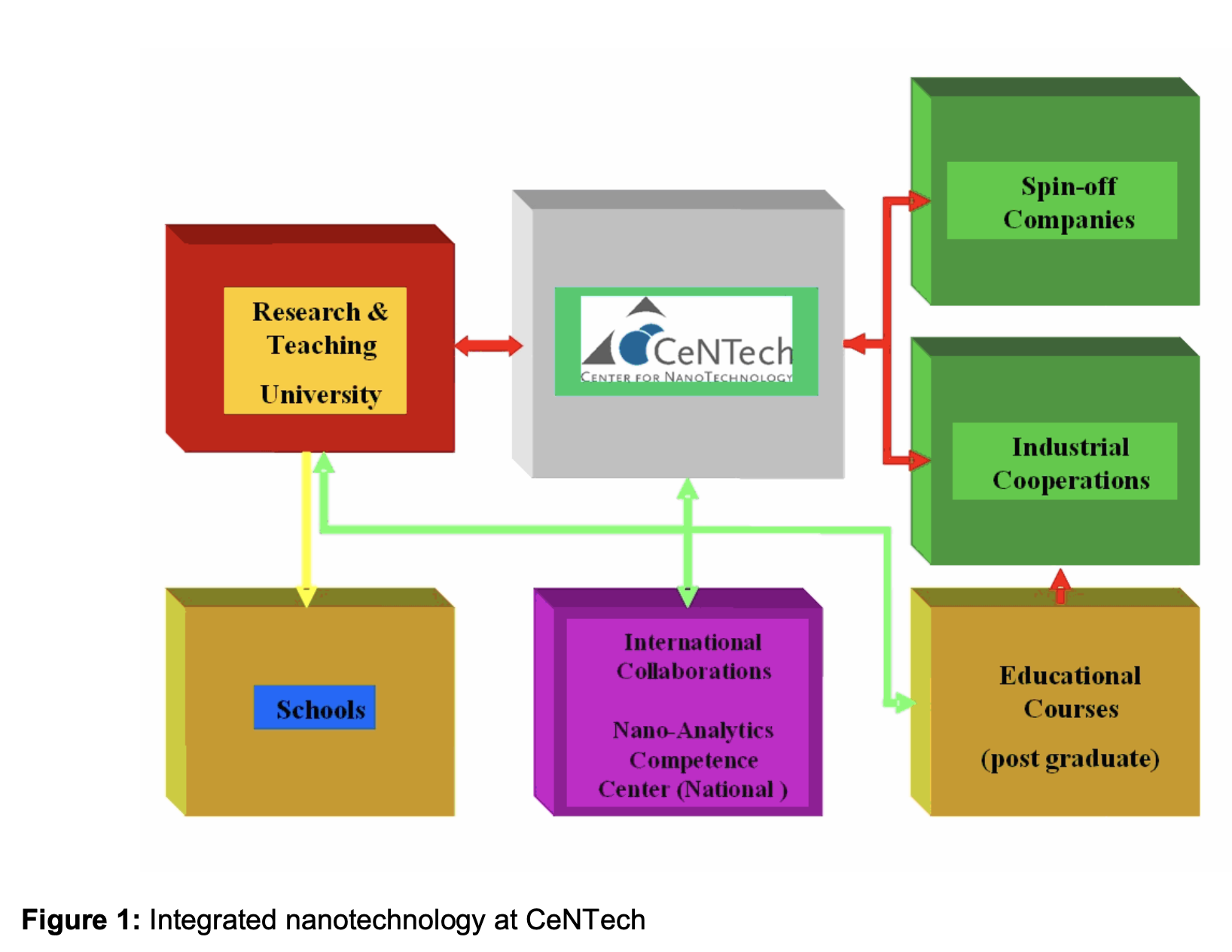
The general research strategy follows a concept that formed the basis of a seminal scientific suc- cess in research laboratories of big US companies and which led to an unprecedented technological leadership over many decades. It consists, on the one hand of a fairly general topical framework or goal, which is sufficiently flexible to guarantee that new and completely unexpected technology leaps can occur, far beyond existing knowledge, linear product optimization strategies and the ostensible increase of market shares. On the other hand the general vision based on the product portfolio of the company had to be considered. Such a strategy has been leading, for example, to innovations such as the transistor, scanning probe microscopy, and high temperature superconductivity, to name a few. All these discoveries had a highly disruptive character making it virtually impossible to foresee their outcome just by evolutionary linear develop- ments. The latter are extremely important and, in fact, indispensable in industrial product and method development including road map and milestone concepts etc., but seem much less effi- cient for the exploration of really new frontiers.
In CeNTech R&D, the participating groups originating from physics, chemistry, biology, bio- physics and medicine are dedicated to application aspects of nanoscience and the fields of nano-(bio) analytics, nanomaterials and nanobiotechnology. One third of the total lab space of the CeNTech building is dedicated to nanotechnology-related companies, while the other two thirds of the build- ing are operated by research groups from the uni- versity. The formal barriers for a membership are fairly high. It is first based on a scien- tific/technological proposal describing the re- search approach of the applicant followed by a de- scription of the potential applications. In the case of a successful application the groups have to bring their own personnel and instruments. In ad- dition they have to pay overhead fees for general research related duties of the lab. This means that method development including road map and milestone concepts etc., but seem much less effi- cient for the exploration of really new frontiers.
In CeNTech R&D, the participating groups originating from physics, chemistry, biology, bio- physics and medicine are dedicated to application aspects of nanoscience and the fields of nano-(bio) analytics, nanomaterials and nanobiotechnology. One third of the total lab space of the CeNTech building is dedicated to nanotechnology-related companies, while the other two thirds of the build- ing are operated by research groups from the uni- versity. The formal barriers for a membership are fairly high. It is first based on a scien- tific/technological proposal describing the re- search approach of the applicant followed by a de- scription of the potential applications. In the case of a successful application the groups have to bring their own personnel and instruments. In ad- dition they have to pay overhead fees for general research related duties of the lab. This means that the reach groups cannot participate, if they do not acquire external grants.
This concept resulted not only in over 100 high quality publications and more than 10 patent ap- plications filed after three years but shows effects on the job market as well. More than 25 new posi- tions were created within the last years and col- laborating companies at CeNTech found new common customer markets that would otherwise have been inaccessible for the individual compa- nies. Cooperation with SMEs and large companies from outside resulted in similar effects.
Nanotechnology at CeNTech
Nanotechnology is essentially based on physical and chemical effects that are characteristic for a certain small length scale, and which are not ob- served at larger length scales. As a consequence nanotechnology is rather an enabling technology than a specific technology field such as electronics, automotive or chemical industry. Thus, in contrast to existing technologies novel device and material properties arise, for example, by control of particle size (color, catalytic yield) tailoring electric transport properties, and applying of molecular recogni- tion. This approach has a high potential to lead to disruptive progress in all technology fields, cer- tainly with high risks but eventually substantially bigger economic opportunities as compared to conventional development strategies [5].
Based on the fact that
- physical techniques reach functional structures (mainly in electronics) down to the nanometer scale and microscopy and spectroscopy methods are reaching molecular and atomic resolution,
- chemists can prepare complex cluster- and supramolecular systems, and
- functional biological systems (mem- branes, proteins, molecular motors) are nano-sized,
it becomes self evident that the traditionally well- separated disciplines of physics, chemistry and bi- ology naturally meet on the nanometer scale and can form a platform for novel scientific and tech- nological strategies reaching far beyond the indi- vidual disciplines (Figure 2).
For example, in molecular biology, nanosystems – like proteosomes and molecular motors – are the fundamental machines that drive the cell and they are components of mitochondria, chloroplasts, ribosomes, and the replication and transcription complexes. In catalysis, nanostruc- tures are ideal reaction centres as are the pores of zeolites.
Each of the disciplines has evolved to some ex- tend its own separate view of nanoscience. The opportunities for integrating these views and for sharing tools and techniques developed separately by each field belong to the most attractive activi- ties ongoing in science today. Some of the chal- lenges for research and development at CeNTech are presented below.
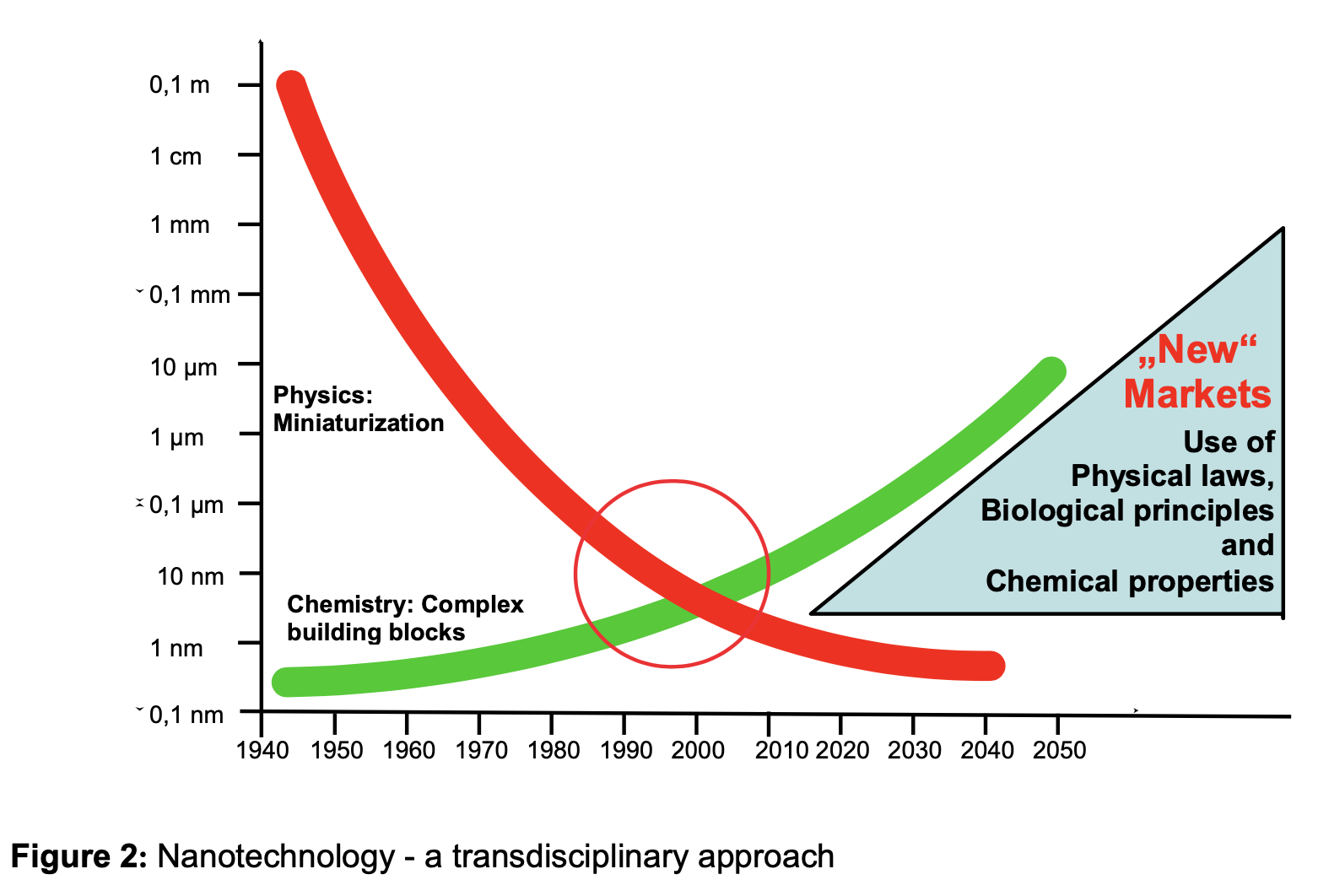
Surface Matters – a Glance at Scientific Work at CeNTech
The development of novel techniques for scan- ning probe microscopy is the prerequisite for an increasingly deeper insight into the nano world. This method is based on a revolutionary micros- copy concept by Gerd Binnig and Heinrich Rohrer from the IBM research laboratory in Zurich, Swit- zerland, who, in 1981, built the first scanning tun- nelling microscope. They were awarded the Nobel Prize in physics in 1986. Their method resulted in the development of a whole family of complemen- tary techniques and made an extremely strong im- pact for getting nanotechnology really started.
Novel methods for improved visualisation of nano-scale structures and for even measuring the forces between individual atoms and molecules are developed at CeNTech. Questions such as the ba- sic mechanics of friction and wear can be ad- dressed on the atomic scale (Figures 3 and 4) [6]. It becomes particular evident in this field that the boarders between basic research and application become fuzzy.
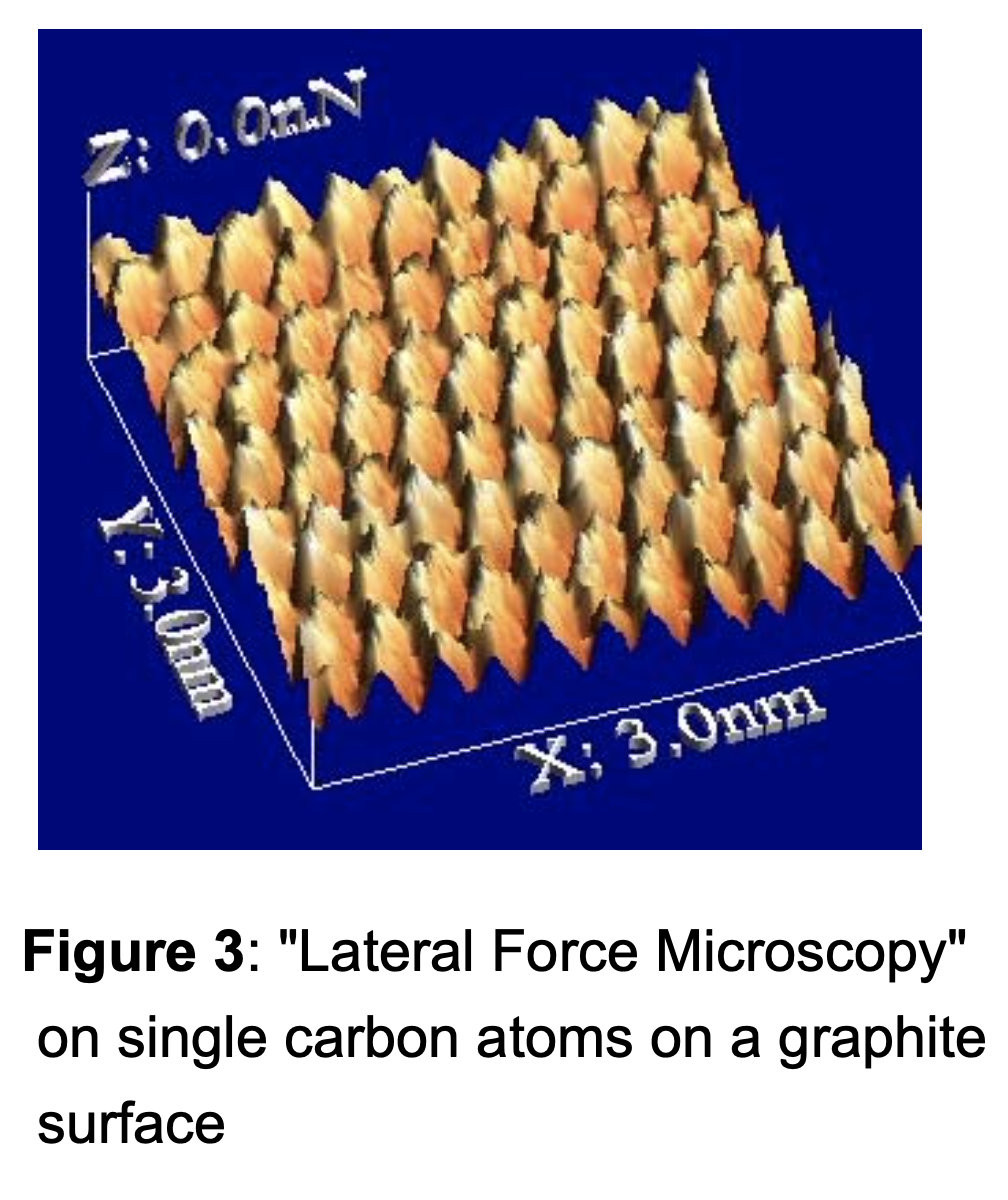
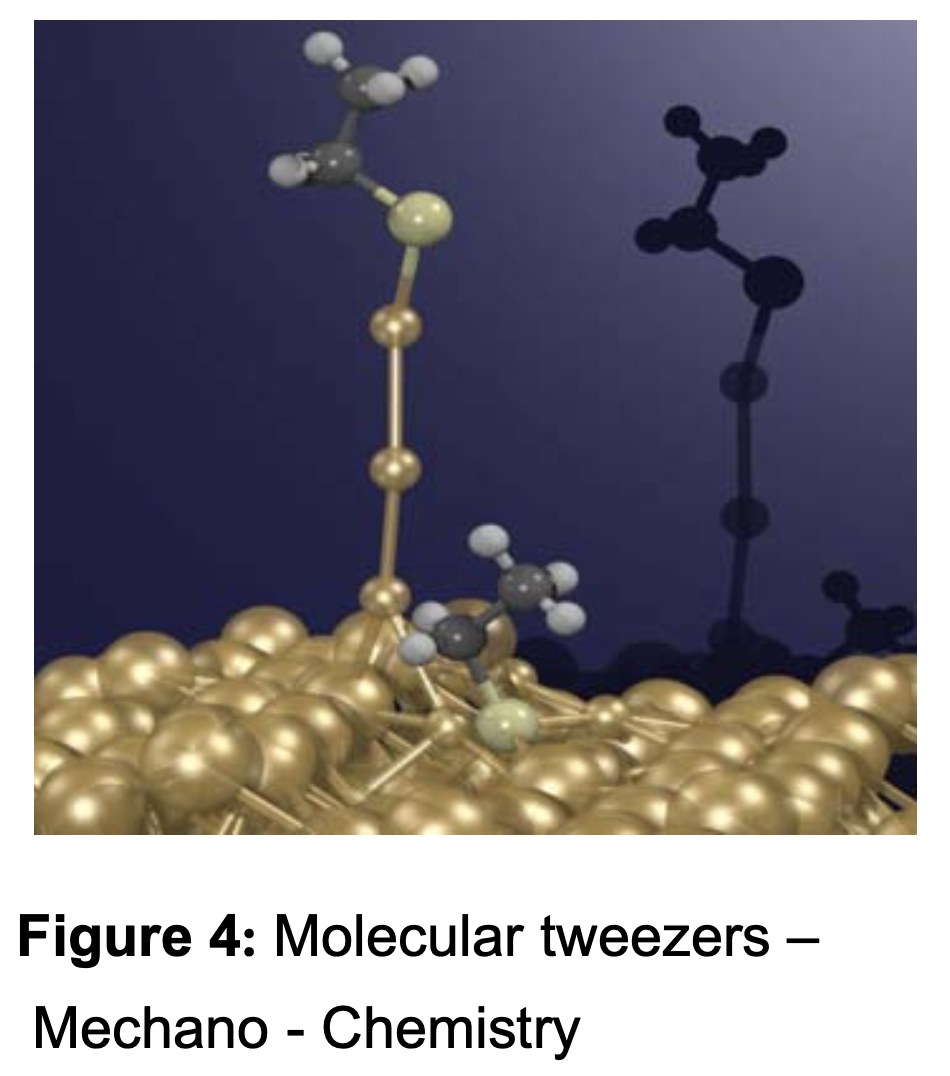
Another topic of CeNTech research is the preparation of self-organised molecular layers. Usually, molecules or atoms – i.e. the building blocks of all materials – are arranged in a more or less randomised fashion in existing products. Us- ing self-organization techniques ubiquitous in bi- ology molecular building blocks arrange them- selves spontaneously and in a well defined posi- tion. They may eventually lead to novel and useful macroscopic systems based on cooperative effects which then are technologically relevant as, for ex- ample, nanostructured templates and scaffolds [7].
Materials produced in this way exhibit totally new electronic and optical properties and, in the extreme case, are only as thick as an atomic or mo- lecular monolayer. This technique is highly de- manded for a whole range of applications. In fu- ture it will be possible to build electronic chips with huge memory capacities, to house a whole bioanaytical laboratory on the size of a thumbnail, or to build organic light emitting diodes with tai- lored optical properties. According to the interdis- ciplinary character, the investigation of interaction between nanoparticles and nanostructured surfaces is another new research topic. Here the action of hose structures on the immune system will be in- vestigated to make a risk assessment and to find new applications for medical devices.
The research fields performed in CeNTech in- clude
- Design of novel scanning-probe tech- niques [8, 9] and advanced optical and x-ray methods.
- Manufacturing and characterisation of supermolecular, self-organizing film- systems (Langmuir-Blodgett, self- assembly-techniques) [4, 7])
- Molecular Beam Epitaxy (MBE) for the construction of novel electronic systems based on organic molecules [4]
- Development of theoretical models re- lated to scanning-probe techniques
Beyond Electron Micoscopy (SEM), Photoelec- tron spectroscopy (XPS) and other surface analyti- cal techniques a state of the art dual beam Focus- sed Ion Beam (FIB) system is available at CeN- Tech. Important applications are nanoscale ma- chining, the modification of the electrical routings on semiconductor devices, the preparation of probes for physico-chemical analysis, or the prepa- ration of ultra precise sections for transmission electron microscopy (TEM), just to mention a few examples. In what dimension manipulation is pos- sible is demonstrated in Figure 5.
In addition to the above mentioned research areas CeNTech offers several groups of young sci- entist the great opportunity to develop their own research fields in nanotechnology.
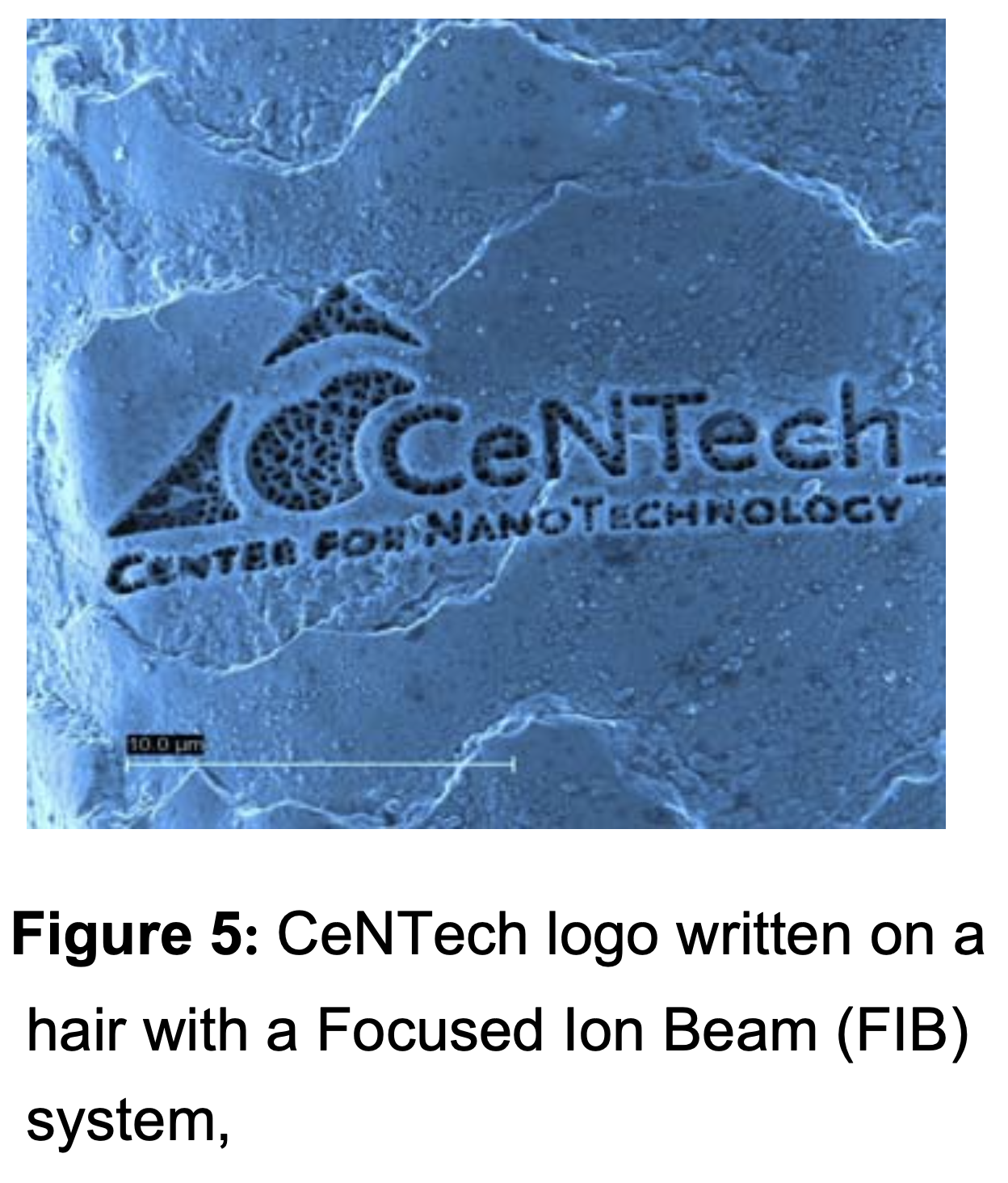
Biological Barriers – Cooperation and Development at CeNTech
Indicative for the interdisciplinary character of nanoscience at CeNTech is the cooperation between the groups. Within the framework of a spe- cial research area of the University of Münster, scientists work together on the deliberate modification of cellular membranes. Biological membranes are made of water-repellent, fat-like molecules with built-in protein molecules serving as transport slices. The whole exchange of matter within and between cells is being arranged and controlled by these slices. Biochemists work on the modification of definite bonds within the fatty acids of the membrane in order to make them less water- repellent, thus gaining novel surface-active proper- ties. To achieve these aims, biochemists use the nanotechnological brick box of the partners [10, 11]. The final application area of this research co- operation is in medicine. The development of im- plants which take root particularly well in the body without causing unwanted immunological repul- sions is only one possible end product of this nano project in Münster.
The presence of the biochemists at CeNTech was not only fruitful for scientific reasons. In co- operation with nanoAnalytics – a company located in CeNTech – a new product was made ready for market: the so-called cellZscope® (Figure 6). With this new device the impedance, i.e. resistance and capacitance of biological barriers can be character- ised as a measure for the correct contact between the cells of a cellular monolayer [12]. It is a tool that can be used e.g. as a substitute for animal testings to investigate drugs and the biocompatibil- ity of nanoparticles.
These are a few examples which demonstrate the interaction between science and SMEs. Other companies and researchers like e.g. a group dealing with the optimization of nanostructures for pro- tein and DNA synthesis are as well successful at CeNTech.
CeNTech fosters not only the interaction between science and industry but also that of SMEs and big companies which leads to new additional market shares on both sides.
Another example for a company hosted by CeNTech is arrows biomedical Deutschland GmbH. It is an independent, international medical and scien- tific consultation and service firm, which advises and supports business, research institutions and hospitals in the area of molecular biomedical sciences. An intensive cooperation with NIKON Mikroskop GmbH enables them to work with advanced high-quality optical microscopes. All employees within the company are physicians and scientists, who continuously work on innovative methods of problem solving in molecular biology and medical science. Close collaboration with all disciplines open contacts and applications within nanoscience as well as in stem cell research. The expanding company appreciates the transdisciplinary environment as well as other companies like Chembiotech, Tascon or nanoAnalytics hosted by CeNTech.
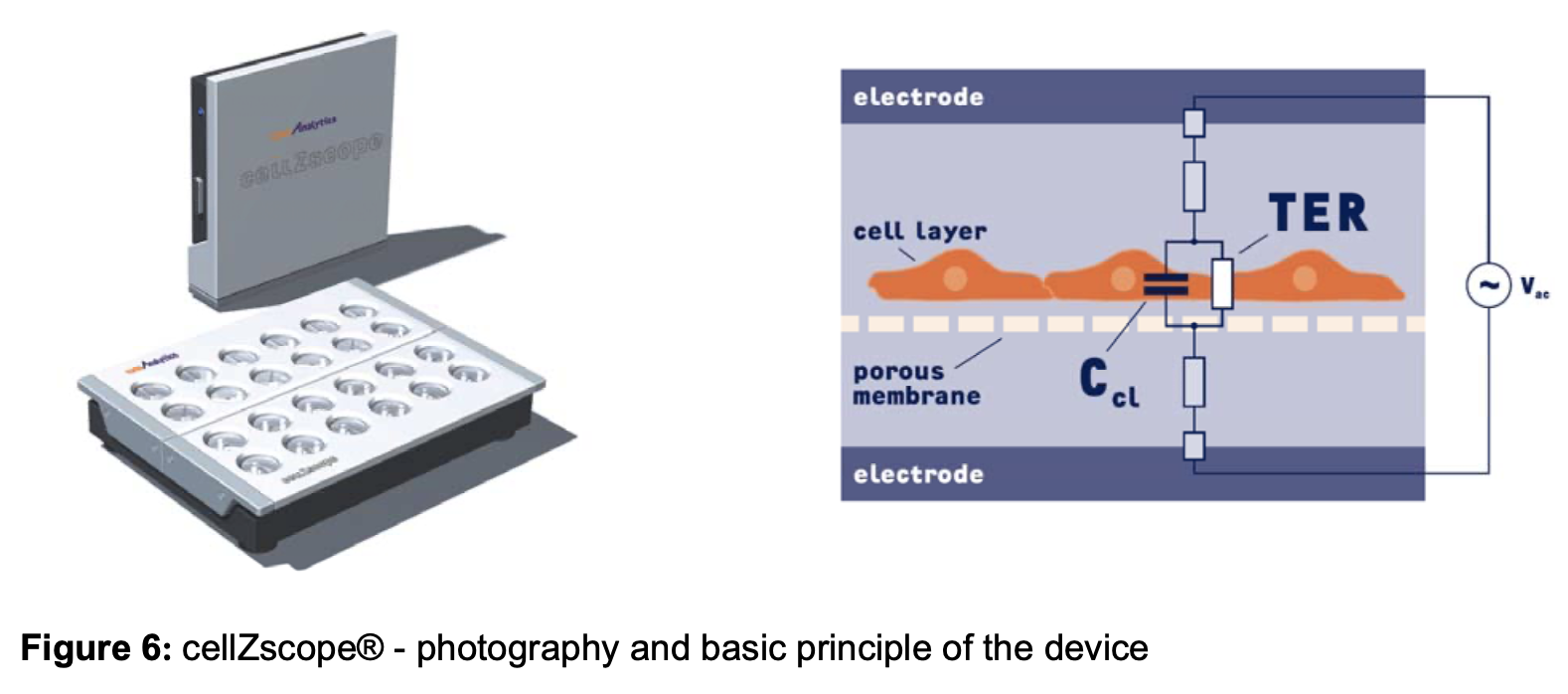
Conclusion
After its first three years of operation CeNTech has formed a new regional platform in the field of nano(bio)technology which combined basic re- search and technology transfer in an efficient way. Researcher groups at CeNTech have acquired more than 12 Mio € during that time on a national and European basis beyond their individual fund- ing in their mother institutions of the University of Münster. Clearly, some of the big instruments such as advanced laser scanning microscopy, UHV- (ultra high vacuum-) surface inspection tools and the Focused Ion Beam system can be used much more efficiently at CeNTech than by an individual group in one of the discipline-separated scientific faculties. The mixing of optimised laboratories, common seminars and meeting rooms etc. gener- ated a new creative atmosphere resulting in much new interdisciplinary collaboration including the in-house companies. CeNTech as a unit also pro- vides strong support for companies and press presentation, education, and workshops. Several young researcher groups were established which are of particular interest for the initiation of new interdisciplinary educational and research ap- proaches. One of the secrets of CeNTech’s suc- cess is the freedom that established groups, and in particular young researchers have in performing their research. This freedom is due to the financial concept that is based on the individual external funding of peer reviewed projects that are har- boured in CeNTech, rather than institutional con- tracts provided by the unit. The dynamics and freedom resulting from this concept as well as in- terdisciplinary science and development creates a great potential for innovation. The job generating effect of CeNTech is the strongest index for the quality of the strategy of this centre.
References
[1] Caciuc, V., Hölscher, H., Blügel, S. & Fuchs H. (2006), First-principles study of the atomic-scale structure of clean silicon tips in dynamic force micro- scopy, Phys. Rev. B, 74, p. 165318
[2] Caciuc, V., Hölscher, H., Blügel, S. & Fuchs, H. (2006), Atomic-scale sharpening of silicon tips in noncontact atomic force microscopy, Phys. Rev. Lett., 96, p. 016101
[3] Peters, R. (2006), Nanoscopic Medicine: The Next Frontier, Small; 2(4), pp.452-56
[4] Du, S. X., Gao, H. J., Seidel, C., Tsetseris, L., Ji, W., Kopf, H., Chi, L. F., Fuchs H., Pennycook, S. J. & Pantelides, S. T. (2006), Selective nontemplated adsorption of organic mole- cules on nanofacets and the role of bonding patterns, Phys. Rev. Lett., 97, p 156105
[5] Fuchs, H., (2004), Nanotechnologie-Chance oder Risiko, Akademie Journal, pp. 48-54
[6] Evstigneev, M., Schirmeisen, A., Jansen, L., Fuchs, H., & Reimann P.(2006), Force depend- ence of transition rates in atomic friction, Phys. Rev. Lett., 97, p. 240601
[7] Chen, X., Rogach, A. L., Talapin, D. V., Fuchs, H. & Chi, L. F. (2006), Hierarchical luminescence patterning based on multiscaled self- assembly, J. Am. Chem. Soc., 128, p. 9592
[8] Jersch, J., Maletzky, T. & Fuchs, H. (2006), Interface circuits for quartz crystal sensors in scan- ning probe microscopy applications, Rev. Sci. In- strum., 77, p. 083701
[9] Schäffer, T. E., Anczykowski, B. & Fuchs, H. (2006), Scanning ION conductance microscopy, pp. 91-119, in: B. Bhushan, H. Fuchs (Edt.), Applied scanning probe methods II, Springer Verlag
[10] Dreger, K., Zou, B., Mu, Z., Galla, H. J., Chi, L. F., Fuchs, H., & Schäfer, H. J. (2006), Synthesis and surface properties of new ureas and amides at different interfaces, Langmuir, 22, p. 1619
[11] Schrot,S.,Weidenfeller,C.,Schäffer,T.E., Robenek, H. & Galla, H. J. (2005), Influence of hydrocortisone on the mechanical properties of the cerebral endothelium in vitro, Biophysical Jour- nal, 89, p. 3904
[12] Wegener, J., Abrams, D., Willenbrink, W. & Janshoff, A. (2004), An automated multi-well device to measure transepithelial electrical resistances under physiological conditions, BioTechniques, 37, pp. 590-597